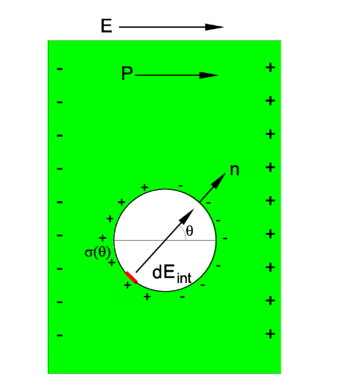Clausius-Mossotti relation
The Clausius-Mossotti relation connects the relative permittivity εr to the polarizability α of the molecules constituting a slab of dielectric.
Internal electric field in dielectric
A macroscopic slab of dielectric is placed in an outer electric field E (the z-direction) that polarizes the dielectric, so that a surface charge density σp is created. Since E "pushes" positive charge and "pulls" negative charge, the sign of the charge density on the outer surface is as is indicated in the figure. The polarization vector P points by definition from negative to positive charge. The surface charge density σp is in absolute value equal to |P|.
An infinitesimally small spherical cavity of radius r is made in the dielectric and inside this cavity there is vacuum with permittivity (electric constant) ε0. Because of electric neutrality the surface of the cavity has the charge density (in absolute value),
where n is a unit length vector perpendicular to the surface of the cavity at the point θ. By definition, the positive direction of the normal n is outward.
An infinitesimal element on the surface of the cavity gives a contribution to the internal electric field Eint parallel to n,
The z-component of this contribution to the field is
Integration over the whole surface gives
The total electric field in the cavity is in the z direction and has magnitude






